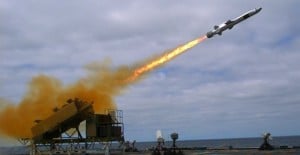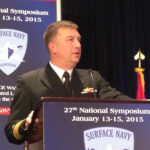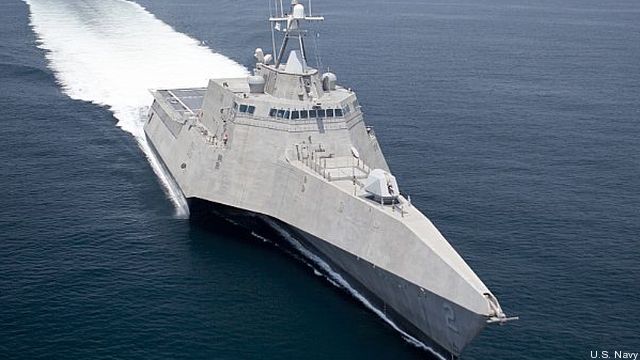Breaking Defence
By SYDNEY J. FREEDBERG JR.



 Once the Littoral Combat Ships got upgunned, the enemy commander could no longer afford to ignore them, explained McGrath, a naval expert and former destroyer commander himself. As a result, enemy intelligence, surveillance, and reconnaissance assets were stretched trying to track all the little but lethal LCS. Enemy decision-makers had to confront an additional danger on every mission, potentially deterring them from aggression altogether. Turning LCS from an auxiliary to a ship-killer literally multiplied the enemy’s problems.
Once the Littoral Combat Ships got upgunned, the enemy commander could no longer afford to ignore them, explained McGrath, a naval expert and former destroyer commander himself. As a result, enemy intelligence, surveillance, and reconnaissance assets were stretched trying to track all the little but lethal LCS. Enemy decision-makers had to confront an additional danger on every mission, potentially deterring them from aggression altogether. Turning LCS from an auxiliary to a ship-killer literally multiplied the enemy’s problems.
By SYDNEY J. FREEDBERG JR.
WASHINGTON: Is the Littoral Combat Ship a real warship? That question has bedeviled the small, sleek, lightly armed ships for years. Now it’s taken on new urgency as the Defense Department and the Navy both refocus on high-intensity, high-tech warfighting against “great powers” — i.e. China and Russia.
Defense Secretary Ash Carter wants to cut the program by a quarter to invest in heavier warships, submarines, aircraft, and missiles. LCS critics charge the ship is only useful forpeacetime patrols and presence missions in low-threat areas. Navy leadership insist it can fight with the battle fleet — especially once it gets a high-powered sonar for hunting subs and long-range missiles for killing ships.
“LCS fits right in the middle of the modern warfight, great powers or not,” said the Navy’s outspoken director of surface warfare, Rear Adm. Peter Fanta, at last week’s Surface Navy Association conference.

Adm. John Richardson
“It is not necessarily as vulnerable [as people think],” said the more reserved Adm. John Richardson, the new Chief of Naval Operations, at a media roundtable during SNA. “It’s got survivability and lethality…. and it has a terrific role to play across that entire spectrum of operations” from humanitarian relief to major war.
“Would you want to send it solo against a high-end threat? Certainly not, but it’s not alone in that world,” said Richardson. His predecessor, Adm. Jonathan Greenert, spoke of heavy-duty Aegis destroyers providing anti-aircraft coverage and missile defense for LCS in high-threat areas — just as they do for aircraft carriers and other vessels.
“We fight as a team, and the Littoral Combat Ship has an important place in that team,” Richardson said. “It is our small surface combatant right now [for] mine hunting, anti-submarine warfare, and… surface warfare.”
Those three roles correspond to the three interchangeable “mission modules” being developed (with much delay) for LCS, which can carry any one of them at a given time. All three are arguably auxiliary missions, at least by comparison to the airstrikes, Tomahawk missile barrages, Marine landings and missile defense provided by capital ships. But all three have the potential to be pivotal in a major war:
- Mine hunting is a long-neglected role in the US Navy, currently relegated to aging MH-53 helicopters and Avenger minesweepers, even though mines have sunk or crippled more US Navy ships since World War II than all other causes combined. Ourpotential adversaries are well aware of the damage mines can do: Iran has at least a thousand, North Korea an estimated 50,000, China 100,000, Russia 250,000. “Minesweeping alone in my opinion justifies a big chunk of the country’s commitment in the Littoral Combat Ship program,” Rep. Joe Courtney, top Democrat on the House seapower subcommittee, told SNA.
- Submarines are another rising threat, with Chinese and Russian fleets growing larger and more advanced. Aegis destroyers have significant anti-submarine warfare capacity, but both the baseline LCS (with the ASW module) and the future LCS frigate(when configured for ASW) will have something destroyers don’t: a “continuous active sonar” with a range in the tens of miles and a “variable depth” feature for finding deep-diving subs. Of course, you could theoretically retrofit these same sensors on a destroyer. But you can buy four LCS for the price of one Arleigh Burke, and when sub-hunting you want to be looking in as many places as possible at once.
- Finally, and perhaps most problematically, the Littoral Combat Ship has its “surface warfare” module. This was originally optimized to fight small boats — “fast attack craft” and “fast inshore attack craft” — of the fast-moving, hard-hitting, but painfully fragile kind favored by the Iranian Revolutionary Guard Corps. That put a premium on relatively short-ranged, quick-firing weapons like 57 millimeter and 30 millimeter cannon.

The LCS Coronado test-fires a new anti-ship missile from Norway’s Kongsberg.
By contrast, the Navy is still struggling to find an anti-ship missile for the LCS, with stopgaps like the Griffin and Longbowhaving only about a five-mile range. Compare the Russian frigate and corvettes — mostly smaller than LCS — which fired missiles from the Caspian Sea a thousandmiles overland into Syria. LCS will probably never achieve that range because the Navydecided against installing its standard multi-purpose missile launcher, the versatile but bulky Vertical Launch System. Instead, the Navy is seeking a mid-range “over the horizon” missile. “We are pushing forward to install over the horizon missiles on LCS this year,” said Fanta.

Rear Adm. Peter Fanta
Once the three modules and the new missile are in service, “LCS fits right in the middle of the modern warfight, great powers or not,” Fanta said.” LCS is perfectly capable of adding the anti-submarine capability, the missile capability, the counter-surface capability, the countermine capability,” Fanta said. “All those missions are part of the warfight. They’re not just part of skirmishes someplace.”
In fact, Fanta frequently says that LCS with medium-range missiles can “put entire enemy fleets on the bottom of the ocean.” Being smaller and less robust than destroyers, the Littoral Combat Ships do take losses along the way, Fanta admits, but in wargames the small warships converge on the enemy in overwhelming numbers, like piranhas.
In a 2014 Navy wargame where LCS was upgraded with medium-range missiles, participantBryan McGrath told Congress, “those ships were no more capable of taking a punch than they previously were; they were capable only of delivering a punch.” But that alone radically changed the adversary’s “risk calculus,” he said.
 Once the Littoral Combat Ships got upgunned, the enemy commander could no longer afford to ignore them, explained McGrath, a naval expert and former destroyer commander himself. As a result, enemy intelligence, surveillance, and reconnaissance assets were stretched trying to track all the little but lethal LCS. Enemy decision-makers had to confront an additional danger on every mission, potentially deterring them from aggression altogether. Turning LCS from an auxiliary to a ship-killer literally multiplied the enemy’s problems.
Once the Littoral Combat Ships got upgunned, the enemy commander could no longer afford to ignore them, explained McGrath, a naval expert and former destroyer commander himself. As a result, enemy intelligence, surveillance, and reconnaissance assets were stretched trying to track all the little but lethal LCS. Enemy decision-makers had to confront an additional danger on every mission, potentially deterring them from aggression altogether. Turning LCS from an auxiliary to a ship-killer literally multiplied the enemy’s problems.
That said, this concept — part of what the Navy calls “distributed lethality” — is very much a work in progress. And there are limits to what even a future LCS can do.
The LCS will never be able to do significant air defense, let alone missile defense, unless the Navy reconsiders its decision not to add a Vertical Launch System. (Interestingly, Lockheed has designed a VLS-equipped variant of LCS that got serious consideration from Saudi Arabia). Nor will it ever be as survivable in the face of battle damage as a destroyer more than twice its tonnage and four times its cost. And the LCS will always have less room for weapons, sensors, and other mission systems than foreign ships its size because of its massive engines, which allow a 40-plus-knot top speed for which tacticians have never fully figured out a use.
All that said, the LCS is still a young ship with both teething troubles and potential for growth. “Our CONOPS will continue to evolve as we send this ship to sea. Every single time we build a new ship we discover new things we can do with it,” Fanta told the Surface Navy Association.
Then, to applause, the admiral quoted Ralph Waldo Emerson: “A foolish consistency is the hobgoblin of little minds.”


No comments:
Post a Comment